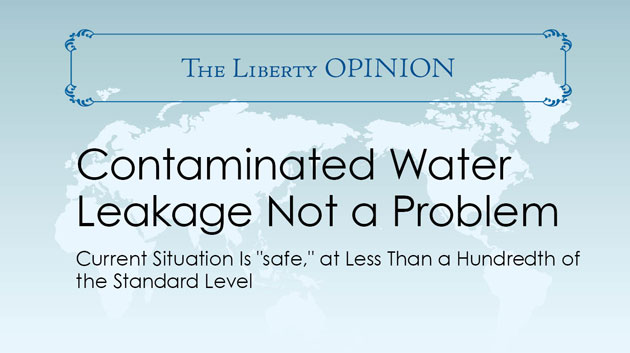Contaminated Water Leakage Not a Problem – The Liberty Opinion
The Liberty Opinion
Contaminated Water Leakage Not a Problem
Current situation is “safe,” at less than a hundredth of the standard level
TEPCO and the problem of the “contaminated water” around the Fukushima No. 1 nuclear power plant has become an ongoing controversy. At the IOC meeting in September too, it was said that this problem was going to hamper the chances of Tokyo being chosen to be the host of the 2020 Olympics. On the 3rd, prior to the Olympics host decision, the government solidified its role in taking the lead of resolving the problem, by pledging some 47 billion yen for such things as creating an “impervious wall” by freezing the soil around the reactor building, and constructing new equipment for removing radioactive material from the contaminated water. Furthermore, on the 19th, Prime Minister Abe requested President Naomi Hirose to clean up the contaminated water. President Hirose responded, “We will secure 1 trillion yen on top of the trillion yen we have already allocated.” The “contaminated water” problem in the media is always sensational, and many people simply think that “the water is dangerous, we must never allow the contaminated water to leak into the ocean.” So then, how dangerous is it exactly?
Less than a hundredth of the standard level that can be safely drunk 2 liters everyday
According to the data at the Nuclear Regulatory Agency, tests for radioactivity concentration in sea water conducted in July at 20 different locations along Fukushima prefecture’s coast showed that within a 20km radius from the nuclear reactor, the highest radioactive cesium concentration (sum total of cesium 134 and 137) recorded was 0.085Bq. Many people may be unfamiliar with the units used to measure contaminated waters and radiation (and so they might not be able to tell right away if such a number is high or low) but the number is indeed extremely low. For instance, according to the WHO the standard level of safety for radioactive cesium in drinking water is set at 10Bq. That means that even the highest concentration found along Fukushima’s coast is less than a hundredth of the standard level. The WHO says that even if we drank 2 liters of the water containing the standard level of 10Bq of radioactive cesium everyday for a year, the cumulative internal radiation exposure will still only be about 0.1mSv. And even if it did exceed the standard level, it would not necessarily be unsuitable to be used as drinking water. If then the concentration in the ocean along the Fukushima coast is less than a hundredth of the standard level it surely must be “safe”. Even if people on land make a big deal that the “contaminated water had leaked,” it ends up getting diluted in the ocean so that there really is no problem.
Need for re-considering countermeasures against contaminated water
On September 2nd, the chairman of the Nuclear Regulation Authority (NRA), Shunichi Tanaka, spoke about the contaminated water’s impact on the ocean at the Foreign Correspondents’ Club of Japan’s press conference. He stated that beyond the coast the radioactive materials were below the detection limit, and went on to say that, “if the radioactive concentration is below the standard level, then we must consider the possibility of releasing the water into the ocean,” which received heavy criticism. However, in response to our coverage, a spokesman from the NRA replied that, “it is more important to ensure that radioactivity does not exceed the standard level in the ocean, rather than whether contaminated water has leaked or not.” This is a perfectly reasonable perspective. Even the NRA that has cautiously dealt with nuclear plants for a long time, that has studied active faults where it is impossible to predict earthquakes, is now considering the possibility of releasing contaminated water into the ocean. It is necessary to consider some things such as diluting tritium, which gets absorbed by water molecules. However there seems to be a need for re-considering the necessity for “countermeasures against contaminated water” that the government and TEPCO are trying to advance. If the contaminated water is treated as if it is extremely dangerous when it’s not (thanks to damaging media coverage), then the news released by the media may be doing more harm than the contaminated water itself. Who will be willing then to take responsibility for the rise in taxes to cover the countermeasure expenditures, and the rise in electric fees that are sure to come back and bite us?



















